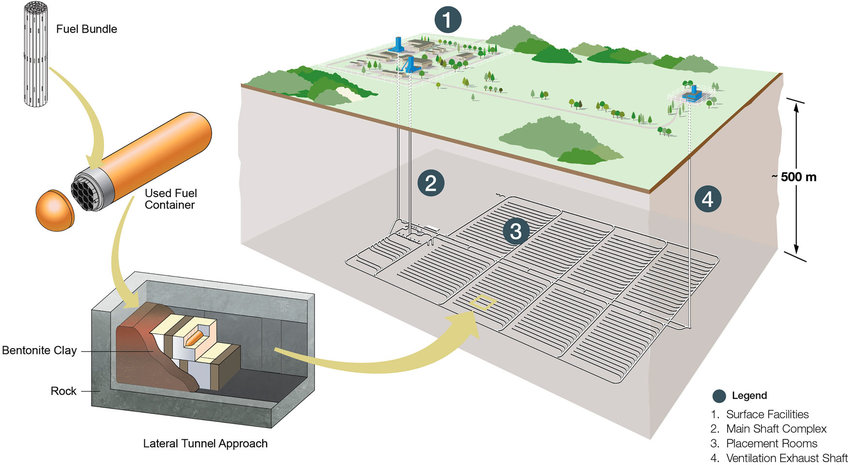What happens to the fuel after it leaves the reactor?

Fuel bundles spend ~2 years (18-36 months) powering the reactor, where they then get transferred into an Olympic-sized swimming pool to cool down for a few years. At this point, a fuel bundle is generating 100 W of heat, equivalent to 1 light bulb. From here the fuel bundles go into dry storage: concrete canisters, the size of a small vehicle, for a few decades. [2]
Canada (and other countries with nuclear power) are looking at building a deep geological repository (DGRs). The plan is called ‘Adaptive Phased Management’. [3] This would bury all of Canada’s spent nuclear fuel in a single facility half a kilometre underground. This facility is being selected so that it can store nuclear waste for a million years without any human intervention needed!
The development of a DGR will cost $16-24 billion. What makes it stand apart from other projects is that it is already entirely funded! A Canadian policy made sure that every uranium fuel bundle used had to have a bit of money set aside to pay to dispose of the waste. Now that technology has advanced a long-term more permanent solution for nuclear waste can be envisioned. Since 1974, nuclear waste has been stored on-site in dry storage facilities. [4]
Some Canadian researchers are looking at ways to use waste fuel in future reactors designs, but this advancement is still hypothetical and very expensive. There are also ways of recycling the fuel, but this process is very expensive. This is part of why a DGR is such an appealing option, the design will allow the plan to adapt as technology improves, which is why it’s called Adaptive Phased Management. [3]
In a 500-metre-deep facility, fuel bundles will be packaged in corrosion-resistant containers, placed in concrete boxes, and sealed with bentonite clay. These facilities will still be accessible until the community and regulators are content and then the access tunnels will then be back-filled. Once a site is selected, construction will commence. The facility will take 40-100 years to construct, prepare, transport, and fill, where it will ultimately be sealed and need no intervention for the million years it takes for the spent nuclear fuel to decay back to background radiation levels.
A handful of DGR research facilities have been operating since the 1980s and a few 100-metre-deep nuclear facilities. The first full-scale deep storage nuclear repository is set to complete in Finland by 2023, with many other facilities around the world under construction or discussion. Canada is currently undergoing the process of commissioning our own deep geologic repository which you can learn more about here: https://www.nwmo.ca/en/A-Safe-Approach/Safety-Protecting-People-and-the-Environment/Why-a-Deep-Geological-Repository
Citations
- Hall, David & Keech, Peter. (2017). An overview of the Canadian corrosion program for the long-term management of nuclear waste. Corrosion Engineering, Science and Technology. 52. 2-5. 10.1080/1478422X.2016.1275419.
- Mukesh, T. and Milan, G. (2015) Essential CANDU: Storage and Disposal of Irradiated fuel Chapter 19. UNENE.
- See for example the Nuclear Waste Management Organization’s explanation of Adaptive Phased Management: https://www.nwmo.ca/en/Canadas-Plan/About-Adaptive-Phased-Management-APM
- https://www.nwmo.ca/en/ABOUT-US/Who-We-Are/Funding
